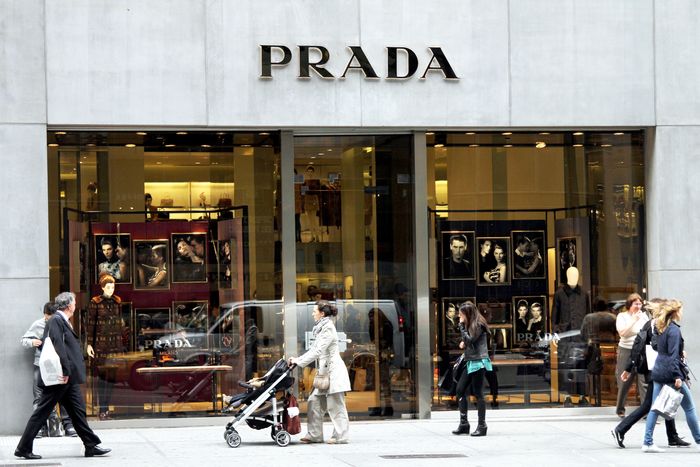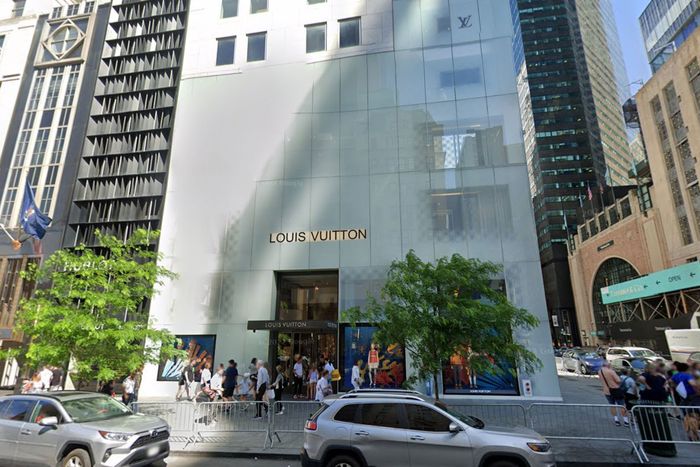Prada is buying its longtime store at 724 Fifth, as well as the building next door, 720 Fifth, in a deal totaling $835 million.
Photo: Paul Brown/Shutterstock
Fifth Avenue, lined with the flagship stores of Cartier, Bergdorf Goodman, Gucci, and other premium luxury brands, is known for its sky-high retail rents — the highest in the world, in fact. But many have wondered whether the strip, which has long epitomized glamour and wealth in New York, would maintain its status despite the rise of online shopping and the economic fallout from COVID. But they needn’t have worried — luxury brands are doing just fine. Their sales, which went up last year, are expected to rise again this year to $77 billion in the U.S. And they’ve found a workaround for those high rents: using the abundance of cash they’re sitting on to buy their own real estate.
In December, Prada agreed to buy 724 Fifth Avenue, home to its flagship boutique since 1997, as well as the building next door, for $835 million. (So far, it hasn’t announced any plans to let go of 841 Madison, the enormous space it’s also been renting less than a mile uptown, but then, it’s long maintained the two locations.) Then, this month, the Kering group, which owns Gucci, Balenciaga, and Alexander McQueen, signed a deal to buy the retail portion of 715–717 Fifth Avenue for $963 million, currently home to Dolce & Gabbana, which is relocating to the Madison Avenue space Hermès occupied until a little over a year ago. LVMH, meanwhile, has plans to demolish its building at 57th Street and Fifth Avenue, as well as the neighboring one, and build a new flagship — a move allegedly motivated, in part, by Rolex’s new ground-up flagship designed by David Chipperfield Architects at 665 Fifth. The luxury conglomerate is also in talks to buy a nearby building, 745 Fifth Avenue, on the corner of 58th Street, as Bloomberg reported.
LVMH has plans to demolish its building at 57th and Fifth Avenue, as well as the neighboring one, and build a new flagship.
Photo: Google Maps
“It’s become an arms race. It’s not good enough to have a Champs-Élysées or Fifth Avenue address; it has to be a flagship with suitable prominence to stand for the brand,” says Mark A. Cohen, the director of retail studies at Columbia Business School. “Not only do these brands spend $800 million to acquire the site like Prada did, but they also spend a fortune on the store redesign.”
To wit, Tiffany & Co. (now part of LVMH) unveiled a new, $250 million Peter Marino redesign last spring. Other brands, like Hermès, are renting larger, showier spaces: Its new 20,250-square-foot flagship opened a little over a year ago with an extravaganza that “shut down a large chunk of Madison Avenue,” via Harper’s Bazaar. And many more are expanding their presence in the city, like Van Cleef & Arpels, which is opening its third store in Manhattan on Madison Avenue. Madison Avenue itself hasn’t had such low vacancy since 2016, according to Avison Young. All of these real-estate transactions on Fifth also suggest that the distinction between Madison Avenue, traditionally the place where the city’s rich prefer to do their shopping, and Fifth Avenue, associated with crowds of lookie-loos just doing some window shopping, may be disappearing.
It’s also a good time to buy. Many luxury retailers are sitting on net cash balances, and spending money on real estate is seen by these luxury behemoths as a solid use of that cash, Deborah Aitken, a senior luxury-retail analyst at Bloomberg Intelligence, wrote in an email. In 2023, LVMH spent $2.66 billion on real estate globally, according to Bloomberg. “We try to secure and buy the best possible locations for our companies,” Bernard Arnault, the chief executive, said on an earnings call earlier this month.
At the same time, real-estate players like Jeff Sutton’s Wharton Properties, which sold the Prada and Gucci buildings, may be motivated to sell because of difficulties securing low-cost financing — shortly before the Prada sale, for example, Sutton refinanced the property with a two-year loan to avoid locking in a high-interest rate on a long-term loan. One of the lenders at the Gucci building also tried to force the property into foreclosure.
This real-estate buying spree is happening beyond New York. Chanel doubled the size of its Beverly Hills flagship, and Gucci now has eight stores in Texas and a boutique in Detroit, according to The Wall Street Journal. Others have expanded their branding beyond stores, building residential towers like the Giorgio Armani residences on Madison Avenue, which has a flagship in the base of the tower and Armani himself living upstairs.
For luxury conglomerates, making a statement with very expensive real estate is simply how the business’s distribution model has evolved — from small side-street stores in Paris and Milan to selling in luxury department stores like Bergdorf and Saks, to increasingly doing the bulk of their sales from flagships, says Cohen. Hence the demand for larger, more eye-catching spaces and ever more extravagant shopping experiences. And they can count on a consistent customer base. “Their underlying core customer is never disadvantaged,” says Cohen. Spending may dip during recessions or other shake-ups, but the buyer never goes away. Unless, that is, they perceive the brand’s stature to be slipping. And a good way to shore it up? Building a more spectacular flagship than the competitor down the street.
Credit: Source link

